Fractional Composition and Toxicity Coal–Rock of PM10-PM0.1 Dust near an Opencast Coal Mining Area and Coal-Fired Power Station
Abstract
:1. Introduction
2. Materials and Methods
2.1. Study Location
2.2. Snow Sampling Process
2.3. Statistical Analysis
2.4. Light Microscopy
2.5. Cell Cultivation and Exposure
2.6. Single-Cell Gel Electrophoresis (Comet Assay)
3. Results and Discussion
3.1. Characteristics of Dust Pollution of Snow Collection Points
3.2. Fractional Composition by Light Microscopy
3.3. DNA Comet Assay
4. Conclusions
Author Contributions
Funding
Institutional Review Board Statement
Informed Consent Statement
Data Availability Statement
Acknowledgments
Conflicts of Interest
References
- Mukherjee, A.; Agrawal, M. World Air Particulate Matter: Sources, Distribution and Health Effects. Environ. Chem. Lett. 2017, 15, 283–309. [Google Scholar] [CrossRef]
- Zheng, M.; Yan, C.; Zhu, T. Understanding Sources of Fine Particulate Matter in China. Philos. Trans. R. Soc. A Math. Phys. Eng. Sci. 2020, 378, 20190325. [Google Scholar] [CrossRef] [PubMed]
- Hendriks, C.; Kranenburg, R.; Kuenen, J.; van Gijlswijk, R.; Wichink Kruit, R.; Segers, A.; van der Gon, H.D.; Schaap, M. The Origin of Ambient Particulate Matter Concentrations in the Netherlands. Atmos. Environ. 2013, 69, 289–303. [Google Scholar] [CrossRef]
- Perrone, M.G.; Vratolis, S.; Georgieva, E.; Török, S.; Šega, K.; Veleva, B.; Osán, J.; Bešlić, I.; Kertész, Z.; Pernigotti, D.; et al. Sources and Geographic Origin of Particulate Matter in Urban Areas of the Danube Macro-Region: The Cases of Zagreb (Croatia), Budapest (Hungary) and Sofia (Bulgaria). Sci. Total Environ. 2018, 619–620, 1515–1529. [Google Scholar] [CrossRef] [PubMed]
- Srimuruganandam, B.; Nagendra, S.M.S. Source Characterization of PM10 and PM2.5 Mass Using a Chemical Mass Balance Model at Urban Roadside. Sci. Total Environ. 2012, 433, 8–19. [Google Scholar] [CrossRef]
- Bray, C.D.; Battye, W.; Uttamang, P.; Pillai, P.; Aneja, V.P. Characterization of Particulate Matter (PM2.5 and PM10) Relating to a Coal Power Plant in the Boroughs of Springdale and Cheswick, PA. Atmosphere 2017, 8, 186. [Google Scholar] [CrossRef] [Green Version]
- Bulejko, P.; Adamec, V.; Schüllerová, B.; Skeřil, R. Levels, Sources, and Health Risk Assessment of Polycyclic Aromatic Hydrocarbons in Brno, Czech Republic: A 5-Year Study. Environ. Sci. Pollut. Res. 2016, 23, 20462–20473. [Google Scholar] [CrossRef]
- Pambudi, R.; Naldi, A.; Luthfi, A.; Puspitarini, D.; Millennia, M.; Permana, M.W.; Safira, S. Spatiotemporal Trend of Particulate Matter (PM 10) Concentration on Cement Industries in Klapanunggal and Citeureup Sub-Districts. IOP Conf. Ser. Earth Environ. Sci. 2020, 561, 012035. [Google Scholar] [CrossRef]
- Richardson, C.; Rutherford, S.; Agranovski, I.E. Open Cut Black Coal Mining: Empirical Verification of PM2.5 Air Emission Estimation Techniques. Atmos. Res. 2019, 216, 151–159. [Google Scholar] [CrossRef]
- Chaulya, S.K. Assessment and Management of Air Quality for an Opencast Coal Mining Area. J Environ. Manag. 2004, 70, 1–14. [Google Scholar] [CrossRef]
- Gautam, S.; Prasad, N.; Patra, A.K.; Prusty, B.K.; Singh, P.; Pipal, A.S.; Saini, R. Characterization of PM2.5 Generated from Opencast Coal Mining Operations: A Case Study of Sonepur Bazari Opencast Project of India. Environ. Technol. Innov. 2016, 6, 1–10. [Google Scholar] [CrossRef]
- Ghose, M.K.; Majee, S.R. Characteristics of Hazardous Airborne Dust Around an Indian Surface Coal Mining Area. Environ. Monit. Assess 2007, 130, 17–25. [Google Scholar] [CrossRef] [PubMed]
- Pless-Mulloli, T.; King, A.; Howel, D.; Stone, I.; Merefield, J. PM10 Levels in Communities Close to and Away from Opencast Coal Mining Sites in Northeast England. Atmos. Environ. 2000, 34, 3091–3101. [Google Scholar] [CrossRef]
- Loewen, M.; Kang, S.; Armstrong, D.; Zhang, Q.; Tomy, G.; Wang, F. Atmospheric Transport of Mercury to the Tibetan Plateau. Environ. Sci. Technol. 2007, 41, 7632–7638. [Google Scholar] [CrossRef] [PubMed]
- Gautam, S.; Patra, A.K.; Sahu, S.P.; Hitch, M. Particulate Matter Pollution in Opencast Coal Mining Areas: A Threat to Human Health and Environment. Int. J. Min. Reclam. Environ. 2018, 32, 75–92. [Google Scholar] [CrossRef] [Green Version]
- Aneja, V.P.; Pillai, P.R.; Isherwood, A.; Morgan, P.; Aneja, S.P. Particulate Matter Pollution in the Coal-Producing Regions of the Appalachian Mountains: Integrated Ground-Based Measurements and Satellite Analysis. J. Air Waste Manag. Assoc. 2017, 67, 421–430. [Google Scholar] [CrossRef] [Green Version]
- Funk, R.; Papke, N.; Hör, B. Wind Tunnel Tests to Estimate PM10 and PM2.5-Emissions from Complex Substrates of Open-Cast Strip Mines in Germany. Aeolian Res. 2019, 39, 23–32. [Google Scholar] [CrossRef]
- Ishtiaq, M.; Jehan, N.; Khan, S.A.; Muhammad, S.; Saddique, U.; Iftikhar, B. Zahidullah Potential Harmful Elements in Coal Dust and Human Health Risk Assessment near the Mining Areas in Cherat, Pakistan. Environ. Sci. Pollut. Res. 2018, 25, 14666–14673. [Google Scholar] [CrossRef]
- Roy, D.; Singh, G.; Seo, Y.-C. Carcinogenic and Non-Carcinogenic Risks from PM10-and PM2.5-Bound Metals in a Critically Polluted Coal Mining Area. Atmos. Pollut. Res. 2019, 10, 1964–1975. [Google Scholar] [CrossRef]
- Nordin, A.P.; da Silva, J.; de Souza, C.T.; Niekraszewicz, L.A.B.; Dias, J.F.; da Boit, K.; Oliveira, M.L.S.; Grivicich, I.; Garcia, A.L.H.; Oliveira, L.F.S.; et al. In Vitro Genotoxic Effect of Secondary Minerals Crystallized in Rocks from Coal Mine Drainage. J. Hazard. Mater. 2018, 346, 263–272. [Google Scholar] [CrossRef]
- Brzezina, J.; Köbölová, K.; Adamec, V. Nanoparticle Number Concentration in the Air in Relation to the Time of the Year and Time of the Day. Atmosphere 2020, 11, 523. [Google Scholar] [CrossRef]
- Li, J.; Garshick, E.; Hart, J.; Li, L.; Shi, L.; Al-Hemoud, A.; Huang, S.; Koutrakis, P. Estimation of Ambient PM 2.5 in Iraq and Kuwait from 2001 to 2018 Using Machine Learning and Remote Sensing. Environ. Int. 2021, 151, 106445. [Google Scholar] [CrossRef] [PubMed]
- Liu, Y.; Fu, B.; Shen, Y.; Yu, Y.; Liu, H.; Zhao, Z.; Zhang, L. Seasonal Properties on PM1 and PGEs (Rh, Pd, and Pt) in PM1. Atmos. Pollut. Res. 2018, 9, 1032–1037. [Google Scholar] [CrossRef]
- Dėdelė, A.; Miškinytė, A. Seasonal and Site-Specific Variation in Particulate Matter Pollution in Lithuania. Atmos. Pollut. Res. 2019, 10, 768–775. [Google Scholar] [CrossRef]
- Krupnova, T.G.; Rakova, O.V.; Struchkova, G.P.; Tikhonova, S.A.; Kapitonova, T.A.; Gavrilkina, S.V.; Bulanova, A.V.; Yakimova, O.N. Insights into Particle-Bound Metal(Loid)s in Winter Snow Cover: Geochemical Monitoring of the Korkinsky Coal Mine Area, South Ural Region, Russia. Sustainability 2021, 13, 4596. [Google Scholar] [CrossRef]
- Freeman, D.L.; Watson, J.; Chow, J.; Egami, R.T. PM10 Source Apportionment for Mining Operations. In Environmental Management for the 1990s; Society for Mining, Metallurgy, and Exploration: Littleton, CO, USA, 1991; pp. 99–104. [Google Scholar]
- Wang, Z.; Zhou, W.; Jiskani, I.M.; Luo, H.; Ao, Z.; Mvula, E.M. Annual Dust Pollution Characteristics and Its Prevention and Control for Environmental Protection in Surface Mines. Sci. Total Environ. 2022, 825, 153949. [Google Scholar] [CrossRef]
- Pandey, B.; Agrawal, M.; Singh, S. Assessment of Air Pollution around Coal Mining Area: Emphasizing on Spatial Distributions, Seasonal Variations and Heavy Metals, Using Cluster and Principal Component Analysis. Atmos. Pollut. Res. 2014, 5, 79–86. [Google Scholar] [CrossRef] [Green Version]
- Alfonsi, L.L.; Macrì, P.; Nazzari, M. Rock Magnetic and Micro-Morphological Analysis on Snow Deposits: Recognition of Anthropogenic Origin of Particulate Matter in Urban and Wilderness Areas (Central Italy). Ann. Geophys. 2021, 64, GM215. [Google Scholar] [CrossRef]
- Gaberšek, M.; Gosar, M. Meltwater Chemistry and Characteristics of Particulate Matter Deposited in Snow as Indicators of Anthropogenic Influences in an Urban Area. Environ. Geochem. Health 2021, 43, 2583–2595. [Google Scholar] [CrossRef]
- Talovskaya, A.V.; Volodina, D.A.; Yazikov, E.G. Macroelement and Mineral-Phase Composition of Particulate Matter in the Impacted Area of Cement Production Plant Based on Snow Cover Study (Kemerovo Region). CSD 2019, 180–189. [Google Scholar] [CrossRef]
- Mezina, K.; Melgunov, M.; Belyanin, D. 7Be, 210Pbatm and 137Cs in Snow Deposits in the Arctic Part of Western Siberia (Yamal-Nenets Autonomous District). Atmosphere 2020, 11, 825. [Google Scholar] [CrossRef]
- Nazarenko, Y.; Fournier, S.; Kurien, U.; Rangel-Alvarado, R.B.; Nepotchatykh, O.; Seers, P.; Ariya, P.A. Role of Snow in the Fate of Gaseous and Particulate Exhaust Pollutants from Gasoline-Powered Vehicles. Environ. Pollut. 2017, 223, 665–675. [Google Scholar] [CrossRef] [PubMed]
- Luong, L.T.M.; Dang, T.N.; Thanh Huong, N.T.; Phung, D.; Tran, L.K.; Van Dung, D.; Thai, P.K. Particulate Air Pollution in Ho Chi Minh City and Risk of Hospital Admission for Acute Lower Respiratory Infection (ALRI) among Young Children. Environ. Pollut. 2020, 257, 113424. [Google Scholar] [CrossRef] [PubMed]
- Priyankara, S.; Senarathna, M.; Jayaratne, R.; Morawska, L.; Abeysundara, S.; Weerasooriya, R.; Knibbs, L.D.; Dharmage, S.C.; Yasaratne, D.; Bowatte, G. Ambient PM2.5 and PM10 Exposure and Respiratory Disease Hospitalization in Kandy, Sri Lanka. Int. J. Environ. Res. Public Health 2021, 18, 9617. [Google Scholar] [CrossRef]
- Bulejko, P.; Adamec, V.; Skeřil, R.; Schüllerová, B.; Bencko, V. Levels and Health Risk Assessment of PM10 Aerosol in Brno, Czech Republic. Cent. Eur. J. Public Health 2017, 25, 129–134. [Google Scholar] [CrossRef] [Green Version]
- Calderón-Garcidueñas, L.; Stommel, E.W.; Rajkumar, R.P.; Mukherjee, P.S.; Ayala, A. Particulate Air Pollution and Risk of Neuropsychiatric Outcomes. What We Breathe, Swallow, and Put on Our Skin Matters. Int. J. Environ. Res. Public Health 2021, 18, 11568. [Google Scholar] [CrossRef]
- Ljungman, P.L.S.; Andersson, N.; Stockfelt, L.; Andersson, E.M.; Nilsson Sommar, J.; Eneroth, K.; Gidhagen, L.; Johansson, C.; Lager, A.; Leander, K.; et al. Long-Term Exposure to Particulate Air Pollution, Black Carbon, and Their Source Components in Relation to Ischemic Heart Disease and Stroke. Environ. Health Perspect. 2019, 127, 107012. [Google Scholar] [CrossRef] [Green Version]
- Omori, T.; Fujimoto, G.; Yoshimura, I.; Nitta, H.; Ono, M. Original Article Effects of Particulate Matter on Daily Mortality in 13 Japanese Cities. J. Epidemiol. 2003, 13, 314–322. [Google Scholar] [CrossRef] [Green Version]
- Cortes-Ramirez, J.; Naish, S.; Sly, P.; Jagals, P. Mortality and Morbidity in Populations in the Vicinity of Coal Mining: A Systematic Review. BMC Public Health 2018, 18, 721. [Google Scholar] [CrossRef] [Green Version]
- Espitia-Pérez, L.; da Silva, J.; Espitia-Pérez, P.; Brango, H.; Salcedo-Arteaga, S.; Hoyos-Giraldo, L.S.; de Souza, C.T.; Dias, J.F.; Agudelo-Castañeda, D.; Valdés Toscano, A.; et al. Cytogenetic Instability in Populations with Residential Proximity to Open-Pit Coal Mine in Northern Colombia in Relation to PM10 and PM2.5 Levels. Ecotoxicol. Environ. Saf. 2018, 148, 453–466. [Google Scholar] [CrossRef]
- Fernández-Navarro, P.; Garcia-Perez, J.; Ramis, R.; Boldo, E.; Lopez-Abente, G. Proximity to Mining Industry and Cancer Mortality. Sci. Total Environ. 2012, 435–436, 66–73. [Google Scholar] [CrossRef] [PubMed]
- León-Mejía, G.; Silva, L.F.O.; Civeira, M.S.; Oliveira, M.L.S.; Machado, M.; Villela, I.V.; Hartmann, A.; Premoli, S.; Corrêa, D.S.; Da Silva, J.; et al. Cytotoxicity and Genotoxicity Induced by Coal and Coal Fly Ash Particles Samples in V79 Cells. Environ. Sci. Pollut. Res. Int. 2016, 23, 24019–24031. [Google Scholar] [CrossRef] [PubMed]
- Ianistcki, M.; Dallarosa, J.; Sauer, C.; Teixeira, C.E.; da Silva, J. Genotoxic Effect of Polycyclic Aromatic Hydrocarbons in the Metropolitan Area of Porto Alegre, Brazil, Evaluated by Helix Aspersa (Müller, 1774). Environ. Pollut. 2009, 157, 2037–2042. [Google Scholar] [CrossRef] [PubMed]
- Cui, X.; Zhou, T.; Shen, Y.; Rong, Y.; Zhang, Z.; Liu, Y.; Xiao, L.; Zhou, Y.; Li, W.; Chen, W. Different Biological Effects of PM2.5 from Coal Combustion, Gasoline Exhaust and Urban Ambient Air Relate to the PAH/Metal Compositions. Environ. Toxicol. Pharmacol. 2019, 69, 120–128. [Google Scholar] [CrossRef] [PubMed]
- Corsini, E.; Vecchi, R.; Marabini, L.; Fermo, P.; Becagli, S.; Bernardoni, V.; Caruso, D.; Corbella, L.; Dell’Acqua, M.; Galli, C.L.; et al. The Chemical Composition of Ultrafine Particles and Associated Biological Effects at an Alpine Town Impacted by Wood Burning. Sci. Total Environ. 2017, 587–588, 223–231. [Google Scholar] [CrossRef]
- Oh, S.M.; Kim, H.R.; Park, Y.J.; Lee, S.Y.; Chung, K.H. Organic Extracts of Urban Air Pollution Particulate Matter (PM2.5)-Induced Genotoxicity and Oxidative Stress in Human Lung Bronchial Epithelial Cells (BEAS-2B Cells). Mutat. Res./Genet. Toxicol. Environ. Mutagen. 2011, 723, 142–151. [Google Scholar] [CrossRef]
- Matzenbacher, C.A.; Garcia, A.L.H.; dos Santos, M.S.; Nicolau, C.C.; Premoli, S.; Corrêa, D.S.; de Souza, C.T.; Niekraszewicz, L.; Dias, J.F.; Delgado, T.V.; et al. DNA Damage Induced by Coal Dust, Fly and Bottom Ash from Coal Combustion Evaluated Using the Micronucleus Test and Comet Assay in Vitro. J. Hazard. Mater. 2017, 324, 781–788. [Google Scholar] [CrossRef]
- Cho, H.-K.; Park, C.-G.; Shin, H.-J.; Park, K.; Lim, H.-B. In Vitro Toxicological Activity of Particulate Matter Generated by Coal Combustion. Environ. Toxicol. Pharmacol. 2018, 64, 187–195. [Google Scholar] [CrossRef]
- León-Mejía, G.; Machado, M.N.; Okuro, R.T.; Silva, L.F.O.; Telles, C.; Dias, J.; Niekraszewicz, L.; Da Silva, J.; Henriques, J.A.P.; Zin, W.A. Intratracheal Instillation of Coal and Coal Fly Ash Particles in Mice Induces DNA Damage and Translocation of Metals to Extrapulmonary Tissues. Sci. Total Environ. 2018, 625, 589–599. [Google Scholar] [CrossRef]
- Ullah, I.; Zahid, M.; Jawad, M.; Arsh, A. Assessment of DNA Damage and Oxidative Stress among Traffic Conductors and Coal Miners. Pak. J. Med. Sci. 2021, 37. [Google Scholar] [CrossRef]
- Espitia-Pérez, L.; Arteaga-Pertuz, M.; Soto, J.S.; Espitia-Pérez, P.; Salcedo-Arteaga, S.; Pastor–Sierra, K.; Galeano–Páez, C.; Brango, H.; da Silva, J.; Henriques, J.A.P. Geospatial Analysis of Residential Proximity to Open-Pit Coal Mining Areas in Relation to Micronuclei Frequency, Particulate Matter Concentration, and Elemental Enrichment Factors. Chemosphere 2018, 206, 203–216. [Google Scholar] [CrossRef] [PubMed] [Green Version]
- Cabarcas-Montalvo, M.; Olivero-Verbel, J.; Corrales-Aldana, H. Genotoxic Effects in Blood Cells of Mus Musculus and Iguana Iguana Living near Coal Mining Areas in Colombia. Sci. Total Environ. 2012, 416, 208–214. [Google Scholar] [CrossRef] [PubMed]
- Nayak, T.; Roy Chowdhury, I. Health Damages from Air Pollution: Evidence from Opencast Coal Mining Region of Odisha, India. Ecol. Econ. Soc.–INSEE J. 2020, 1, 43–65. [Google Scholar] [CrossRef]
- Zazouli, M.A.; Dehbandi, R.; Mohammadyan, M.; Aarabi, M.; Dominguez, A.O.; Kelly, F.J.; Khodabakhshloo, N.; Rahman, M.M.; Naidu, R. Physico-Chemical Properties and Reactive Oxygen Species Generation by Respirable Coal Dust: Implication for Human Health Risk Assessment. J. Hazard. Mater. 2021, 405, 124185. [Google Scholar] [CrossRef] [PubMed]
- Borlaza, L.J.S.; Cosep, E.M.R.; Kim, S.; Lee, K.; Joo, H.; Park, M.; Bate, D.; Cayetano, M.G.; Park, K. Oxidative Potential of Fine Ambient Particles in Various Environments. Environ. Pollut. 2018, 243, 1679–1688. [Google Scholar] [CrossRef] [PubMed]
- Integrated Science Assessment for Particulate Matter (December 2019). Available online: https://www.epa.gov/isa/integrated-science-assessment-isa-particulate-matter (accessed on 27 October 2022).
- Luo, H.; Zhou, W.; Jiskani, I.M.; Wang, Z. Analyzing Characteristics of Particulate Matter Pollution in Open-Pit Coal Mines: Implications for Green Mining. Energies 2021, 14, 2680. [Google Scholar] [CrossRef]
- Sahu, S.P.; Patra, A.K.; Kolluru, S.S.R. Spatial and Temporal Variation of Respirable Particles around a Surface Coal Mine in India. Atmos. Pollut. Res. 2018, 9, 662–679. [Google Scholar] [CrossRef]
- Larionov, A.; Volobaev, V.; Zverev, A.; Vdovina, E.; Bach, S.; Schetnikova, E.; Leshukov, T.; Legoshchin, K.; Eremeeva, G. Chemical Composition and Toxicity of PM10 and PM0.1 Samples near Open-Pit Mines and Coal Power Stations. Life 2022, 12, 1047. [Google Scholar] [CrossRef]
- Singh, N.P.; McCoy, M.T.; Tice, R.R.; Schneider, E.L. A Simple Technique for Quantitation of Low Levels of DNA Damage in Individual Cells. Exp. Cell Res. 1988, 175, 184–191. [Google Scholar] [CrossRef] [Green Version]
- OECD. Test No. 489: In Vivo Mammalian Alkaline Comet Assay; Organisation for Economic Co-Operation and Development: Paris, France, 2016. [Google Scholar]
- Lin, Y.; Zou, J.; Yang, W.; Li, C.-Q. A Review of Recent Advances in Research on PM2.5 in China. Int. J. Environ. Res. Public Health 2018, 15, 438. [Google Scholar] [CrossRef]
- Marmett, B.; Carvalho, R.B.; Muccillo-Baisch, A.L.; Baisch, P.R.M.; dos Santos, M.; Garcia, E.M.; Rhoden, C.R.; da Silva Júnior, F.M.R. Emissions Monitoring and Carcinogenic Risk Assessment of PM10-Bounded PAHs in the Air from Candiota’s Coal Activity Area, Brazil. Environ. Geochem. Health 2022. [Google Scholar] [CrossRef] [PubMed]
- Moreno, T.; Trechera, P.; Querol, X.; Lah, R.; Johnson, D.; Wrana, A.; Williamson, B. Trace Element Fractionation between PM10 and PM2.5 in Coal Mine Dust: Implications for Occupational Respiratory Health. Int. J. Coal Geol. 2019, 203, 52–59. [Google Scholar] [CrossRef]
- Liu, Y.; Wang, R.; Zhang, Y.; Zhao, T.; Wang, J.; Wu, H.; Hu, P. Temporal and Spatial Distributions of Particulate Matters around Mining Areas under Two Coal Mining Methods in Arid Desert Region of Northwest China. Environ. Technol. Innov. 2020, 19, 101029. [Google Scholar] [CrossRef]
- Kholodov, A.S.; Tarasenko, I.A.; Zinkova, E.A.; Teodoro, M.; Docea, A.O.; Calina, D.; Tsatsakis, A.; Golokhvast, K.S. The Study of Airborne Particulate Matter in Dalnegorsk Town. Int. J. Environ. Res. Public Health 2021, 18, 9234. [Google Scholar] [CrossRef] [PubMed]
- Schraufnagel, D.E. The Health Effects of Ultrafine Particles. Exp. Mol. Med. 2020, 52, 311–317. [Google Scholar] [CrossRef] [Green Version]
- Marcella, S.; Apicella, B.; Secondo, A.; Palestra, F.; Opromolla, G.; Ciardi, R.; Tedeschi, V.; Ferrara, A.L.; Russo, C.; Rosaria Galdiero, M.; et al. Size-Based Effects of Anthropogenic Ultrafine Particles on Activation of Human Lung Macrophages. Environ. Int. 2022, 166, 107395. [Google Scholar] [CrossRef]
- Phairuang, W.; Suwattiga, P.; Hongtieab, S.; Inerb, M.; Furuuchi, M.; Hata, M. Characteristics, Sources, and Health Risks of Ambient Nanoparticles (PM0.1) Bound Metal in Bangkok, Thailand. Atmos. Environ. X 2021, 12, 100141. [Google Scholar] [CrossRef]
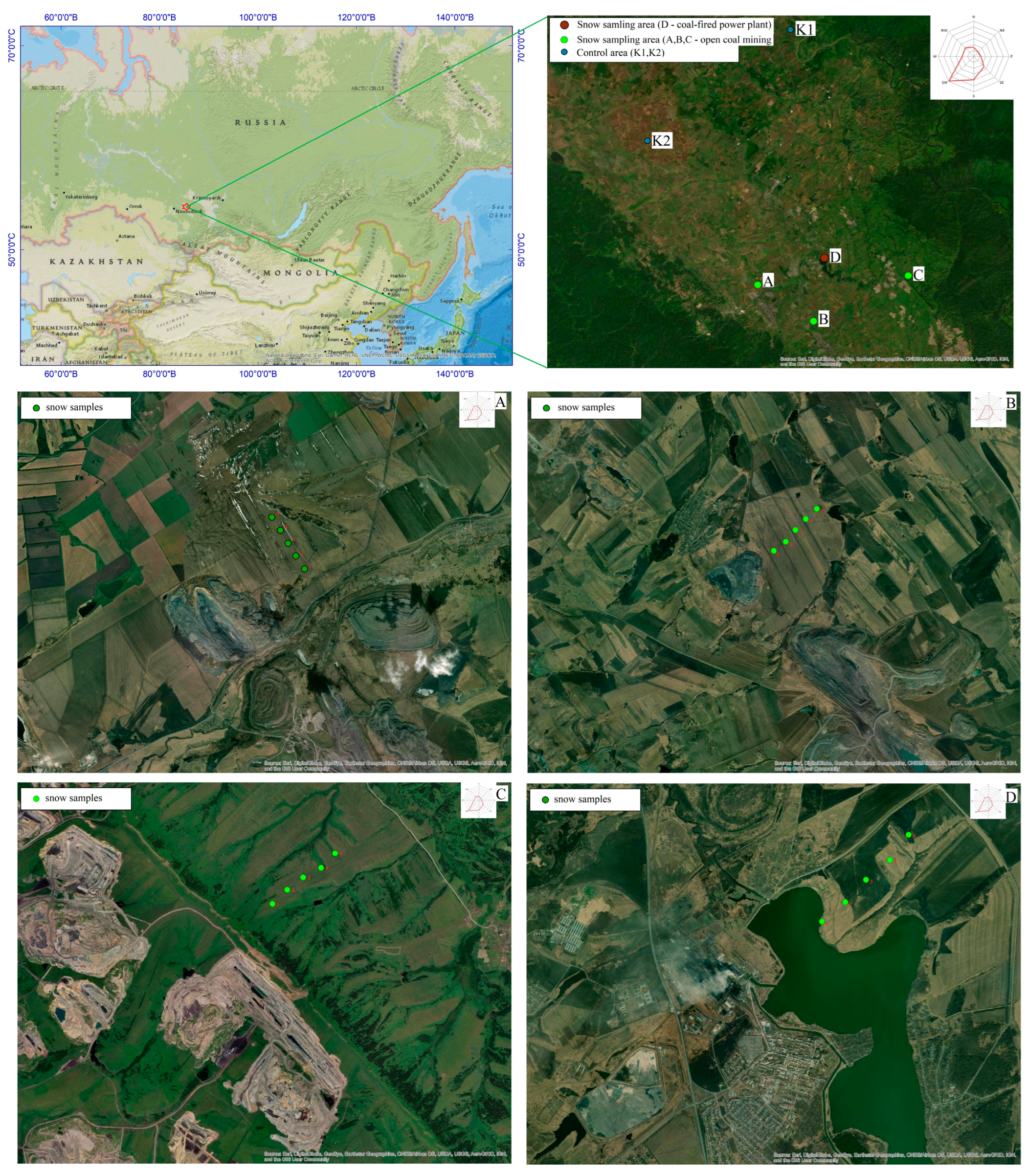
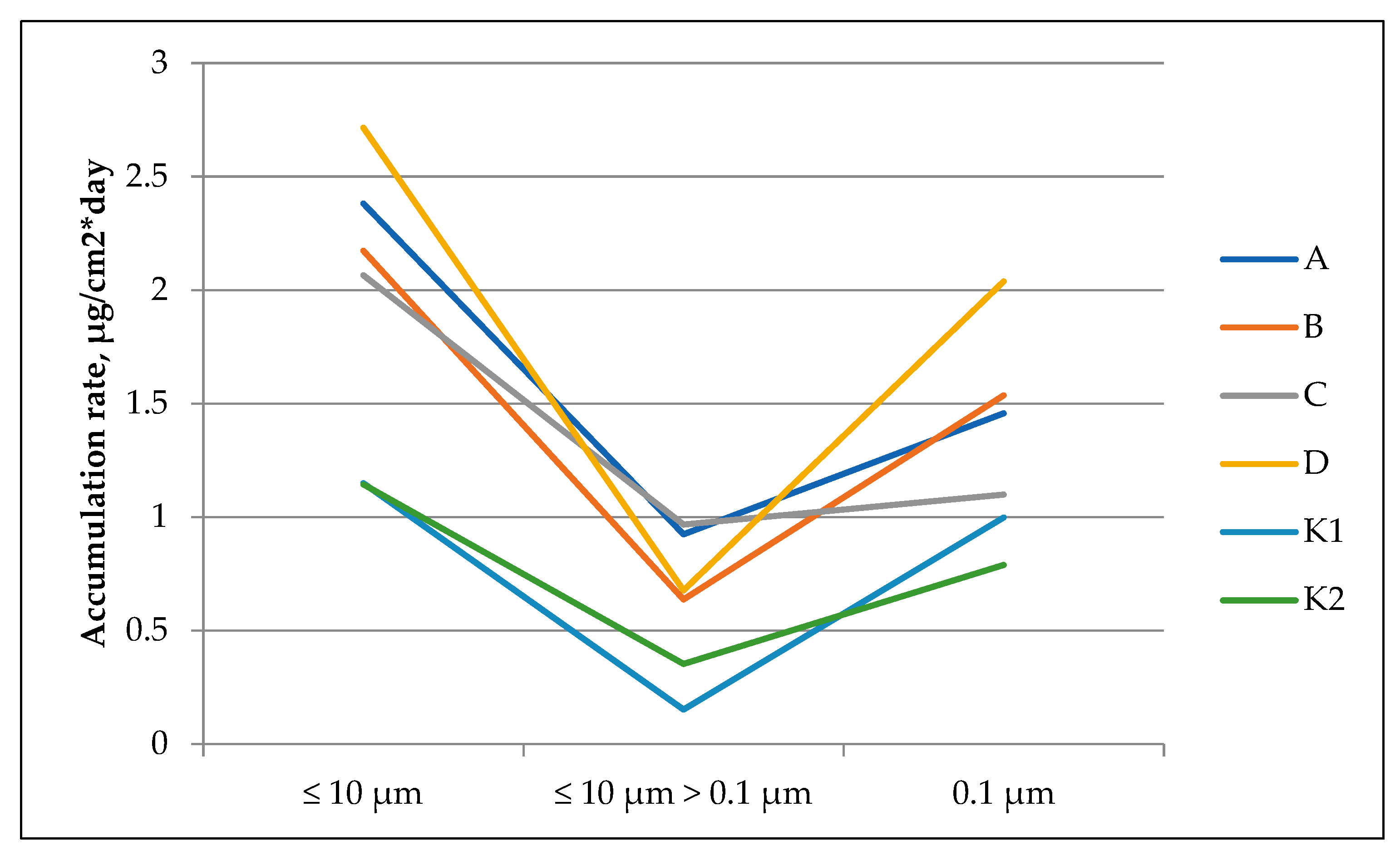
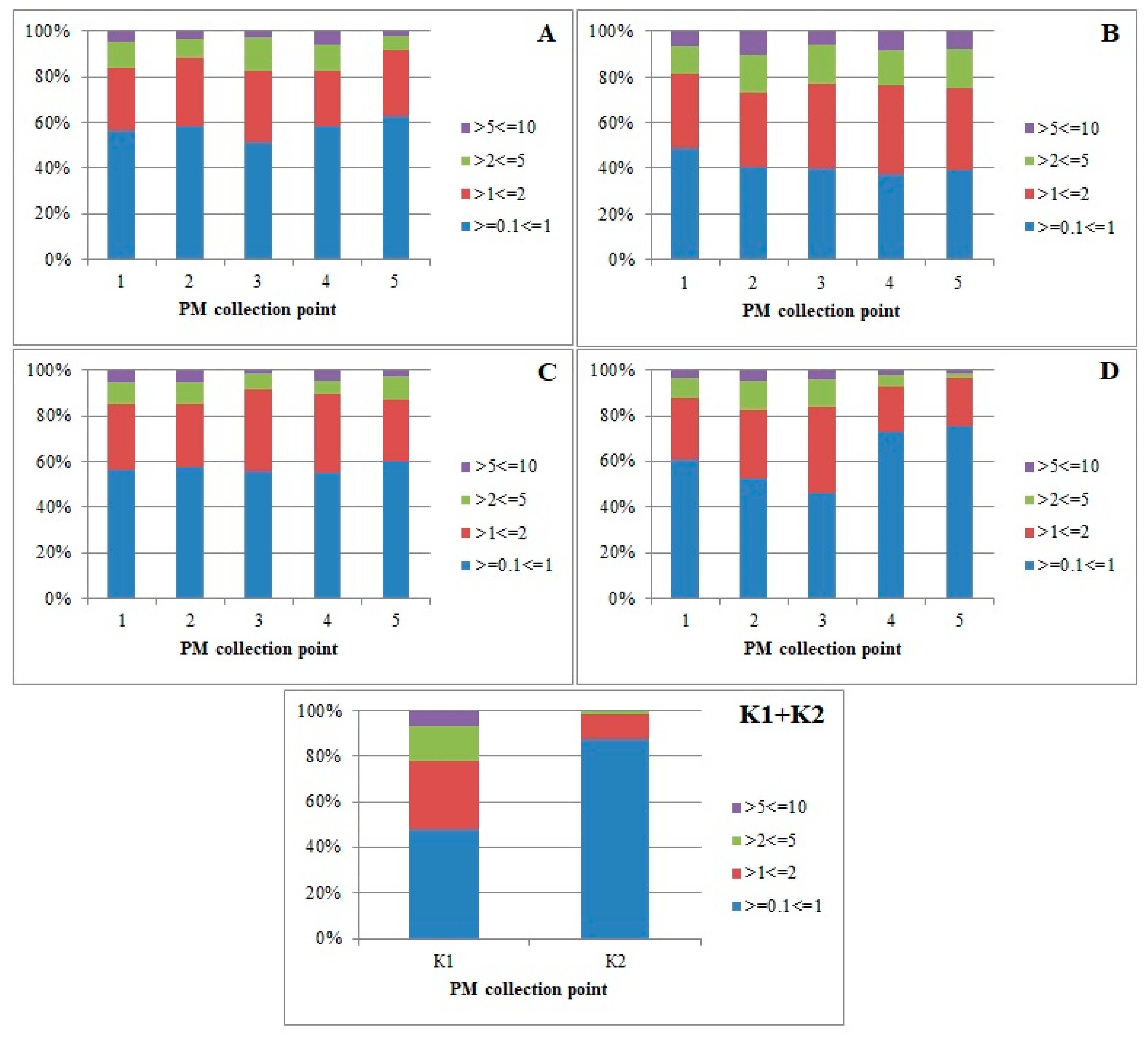
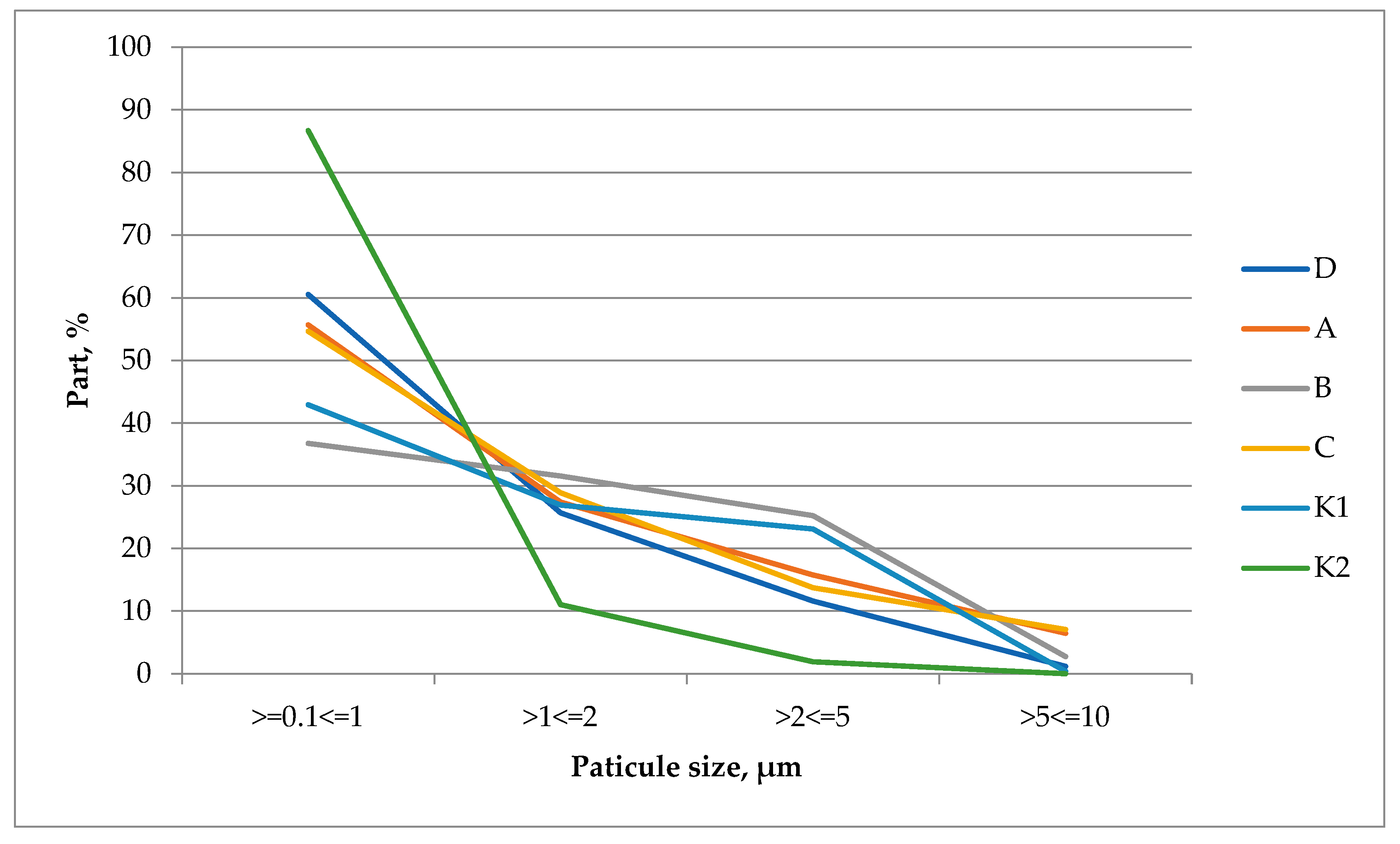

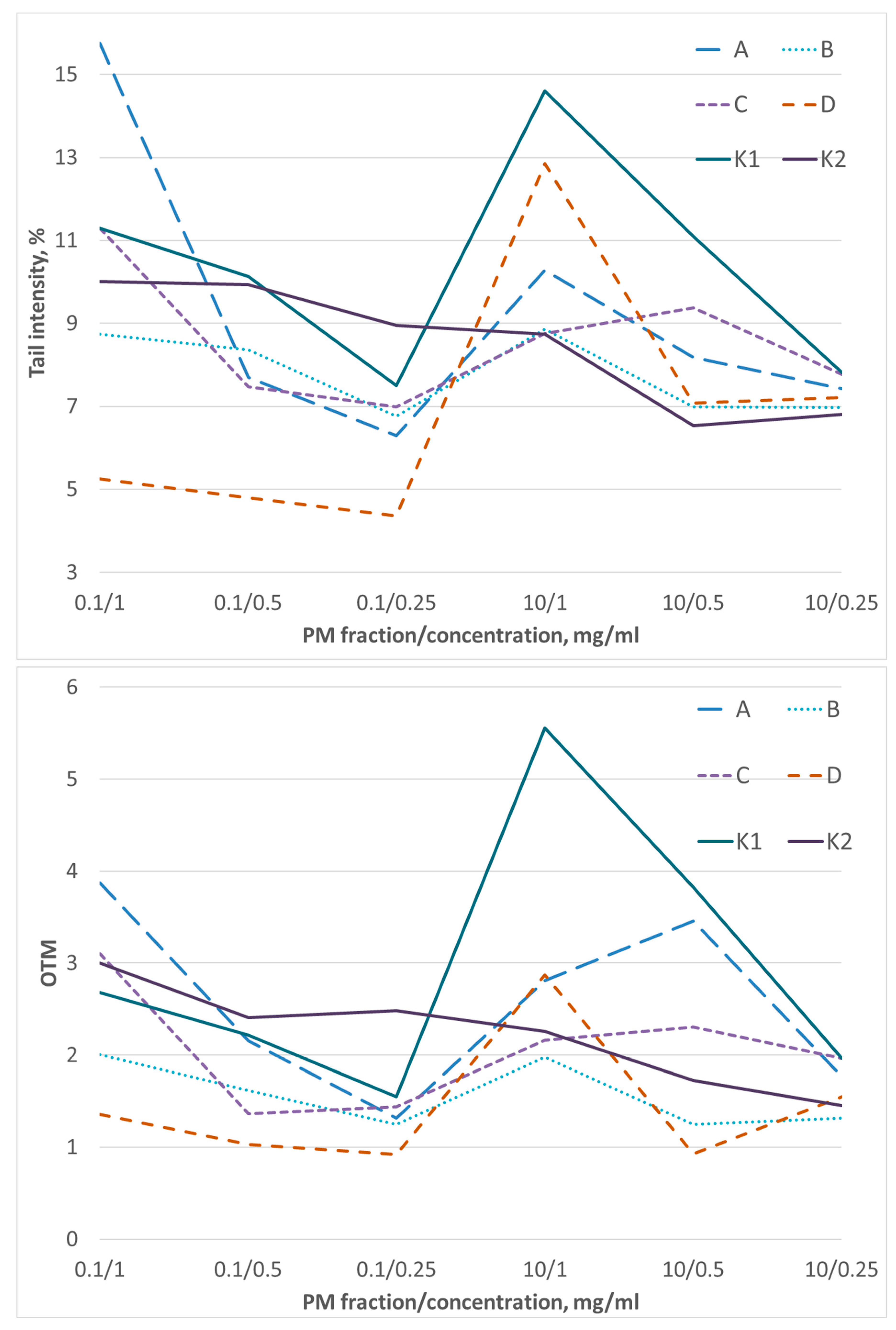
| Samples Area | Symbol | Distance from the First and Other Observation Points to the Industrial Enterprises, m | ||||
|---|---|---|---|---|---|---|
| 1 | 2 | 3 | 4 | 5 | ||
| Open-pit mine “Bachatskiy” | A | 1250 | 1300 | 1480 | 1800 | 2180 |
| Open-pit mine “Novobachatskiy” | B | 500 | 1000 | 1500 | 2000 | 2500 |
| Open-pit mine “Permyakovsky” | C | 1250 | 1750 | 2250 | 2750 | 3250 |
| Coal-fired power station “Belovskaya” | D | 1700 | 2200 | 2700 | 3200 | 3700 |
| Near v. Kuzbasskiy | K1 | >15,000 | ||||
| Near v. Krasnoe | K2 | >25,000 | ||||
| PM Collection Area | Point Number | Snow Samples | |||||
|---|---|---|---|---|---|---|---|
|
Total for the Period of Snow
Accumulation, μg/cm2 | Accumulation Rate, μg/cm2·day | ||||||
| ≤PM10 | ≤PM10 > PM0.1 | ≤PM0.1 | ≤PM10 | ≤PM10 > PM0.1 | ≤PM0.1 | ||
| A | 1 | 536.5 | 263.2 | 273.3 | 4.79 | 2.35 | 2.44 |
| 2 | 331.58 | 88.6 | 242.98 | 2.961 | 0.791 | 2.17 | |
| 3 | 157.8 | 63.2 | 94.6 | 1.409 | 0.564 | 0.845 | |
| 4 | 154.1 | 49.1 | 105 | 1.376 | 0.438 | 0.938 | |
| 5 | 153.3 | 53.2 | 100.1 | 1.369 | 0.475 | 0.894 | |
| Av.1–5 | 266.656 | 103.46 | 163.196 | 2.381 | 0.924 | 1.457 | |
| B | 1 | 472.96 | 114.11 | 358.85 | 3.975 | 0.959 | 3.016 |
| 2 | 190.26 | 40.77 | 149.49 | 1.599 | 0.343 | 1.256 | |
| 3 | 207.96 | 82.83 | 125.13 | 1.748 | 0.696 | 1.052 | |
| 4 | 224.11 | 101.80 | 122.31 | 1.883 | 0.856 | 1.028 | |
| 5 | 197.57 | 39.49 | 158.08 | 1.660 | 0.332 | 1.328 | |
| Av.1–5 | 258.572 | 75.8 | 182.772 | 2.173 | 0.637 | 1.536 | |
| C | 1 | 407.06 | 276.03 | 131.03 | 3.107 | 2.107 | 1 |
| 2 | 152.69 | 62.82 | 89.87 | 1.166 | 0.480 | 0.686 | |
| 3 | 291.15 | 91.92 | 199.23 | 2.223 | 0.702 | 1.521 | |
| 4 | 101.67 | 15.13 | 86.54 | 0.767 | 0.116 | 0.661 | |
| 5 | 400.26 | 187.44 | 212.82 | 3.055 | 1.431 | 1.625 | |
| Av.1–5 | 270.566 | 126.668 | 143.898 | 2.065 | 0.967 | 1.099 | |
| D | 1 | 608.21 | 213.21 | 395 | 5.069 | 1.777 | 3.292 |
| 2 | 265 | 41.03 | 223.97 | 2.208 | 0.342 | 1.866 | |
| 3 | 368.21 | 71.54 | 296.67 | 3.068 | 0.596 | 2.472 | |
| 4 | 187.82 | 59.23 | 128.59 | 1.565 | 0.494 | 1.072 | |
| 5 | 199.49 | 21.03 | 178.46 | 1.662 | 0.175 | 1.487 | |
| Av.1–5 | 325.746 | 81.208 | 244.538 | 2.715 | 0.677 | 2.038 | |
| K1 | 126.41 | 16.67 | 109.74 | 1.149 | 0.152 | 0.998 | |
| K2 | 125.58 | 38.85 | 86.73 | 1.144 | 0.353 | 0.789 | |
| TI, % | OTM | ||
|---|---|---|---|
| MRC-5 | C− | 2.063945 | 0.268355 |
| C+ | 22.01629 | 19.43845 | |
| Cd | 2.757954 | 0.358818 | |
| A549 | C− | 4.021566 | 0.815793 |
| C+ | 23.67538 | 12.36745 | |
| Cd | 4.269289 | 0.903633 | |
Publisher’s Note: MDPI stays neutral with regard to jurisdictional claims in published maps and institutional affiliations. |
© 2022 by the authors. Licensee MDPI, Basel, Switzerland. This article is an open access article distributed under the terms and conditions of the Creative Commons Attribution (CC BY) license (https://creativecommons.org/licenses/by/4.0/).
Share and Cite
Leshukov, T.; Legoshchin, K.; Yakovenko, O.; Bach, S.; Russakov, D.; Dimakova, D.; Vdovina, E.; Baranova, E.; Avdeev, K.; Kolpina, E.; et al. Fractional Composition and Toxicity Coal–Rock of PM10-PM0.1 Dust near an Opencast Coal Mining Area and Coal-Fired Power Station. Sustainability 2022, 14, 16594. https://doi.org/10.3390/su142416594
Leshukov T, Legoshchin K, Yakovenko O, Bach S, Russakov D, Dimakova D, Vdovina E, Baranova E, Avdeev K, Kolpina E, et al. Fractional Composition and Toxicity Coal–Rock of PM10-PM0.1 Dust near an Opencast Coal Mining Area and Coal-Fired Power Station. Sustainability. 2022; 14(24):16594. https://doi.org/10.3390/su142416594
Chicago/Turabian StyleLeshukov, Timofey, Konstantin Legoshchin, Olga Yakovenko, Sebastian Bach, Dmitriy Russakov, Daria Dimakova, Evgeniya Vdovina, Elizaveta Baranova, Kirill Avdeev, Elena Kolpina, and et al. 2022. "Fractional Composition and Toxicity Coal–Rock of PM10-PM0.1 Dust near an Opencast Coal Mining Area and Coal-Fired Power Station" Sustainability 14, no. 24: 16594. https://doi.org/10.3390/su142416594







